WP_Post Object
(
[ID] => 5048
[post_author] => 7
[post_date] => 2021-05-27 12:07:24
[post_date_gmt] => 2021-05-27 18:07:24
[post_content] =>
Despite the challenges that life has thrown at Rashique Ramiz, the graduate student from the Kenneth Levene Graduate School of Business has landed on his feet and procured his dream co-op placement at the Child Trauma Research Centre. Turns out that, as much as Ramiz is getting out of the placement, the Centre is getting much more from him.
University of Regina master's student Rashique Ramiz remembers the day his world changed forever. He had just started a co-op term as the IT communications specialist with the newly-established Child Trauma Research Centre (CTRC). His wife, Faeqa Farooq, was four months pregnant with their first child, and the happy young couple was overjoyed at how their life in Canada was unfolding. Then, on September 29, Ramiz was jolted awake at 5:15 a.m. by the persistent buzz of his cell phone. Panicked, he answered the long-distance call from Bangladesh, bracing for news no child ever wants to hear: his beloved father was gravely ill with a high fever.
"I knew in my heart that something wasn't right. My mother and sister were crying and I felt so helpless and so far away," says the quiet, introspective student from the Kenneth Levene Graduate School of Business. Within an hour, his father was gone.
As the only son and eldest of two children, Ramiz sprang into action to help his family in Bangladesh. Even though he couldn't travel and there was a 12-hour time difference between the two countries, Ramiz used his business acumen to sort through company orders, payroll and staffing concerns of his late father's struggling business. Since that fateful September day, his schedule has been relentless.
Beginning at 9 a.m., he works a full day from home for the Child Trauma Research Centre. He then takes over cooking and cleaning duties to help out his wife and tends to their infant daughter, Raizel. Then, from 9 p.m. until 1:00 a.m., he manages his dad's Bangladeshi business from afar. "The company is barely making enough money to pay salaries and is operating at a loss," he confides. "I've been trying to sell the business, but with COVID-19, times are hard and no one wants to buy. These are very unpredictable times, but I am not giving up. I like a challenge, and I don't need much sleep. So far, I've been able to manage affairs back home plus take on all of the opportunities with my co-op placement."
Anyone facing similar circumstances would probably have reason to be a little morose, but Ramiz is the kind of person who radiates positivity. His can-do attitude and unbridled resourcefulness have earned him the admiration and respect of his colleagues, in particular his supervisor, Dr. Nathalie Reid, CTRC's director.
"I used to be a high school teacher and I've always believed that youth are our future," she enthuses. "Rashique's story is so compelling. He's helping to shape our future by being the focal point of our values and our mission. His creativity, IT and digital knowledge, along with his data analysis, are helping us better respond to child trauma issues at home and abroad, with the ultimate goal of helping to prevent child trauma."
The CTRC was established at the University of Regina in March of 2020 to focus attention on issues and research pertaining to child trauma and its impacts on child and youth mental health and well-being.
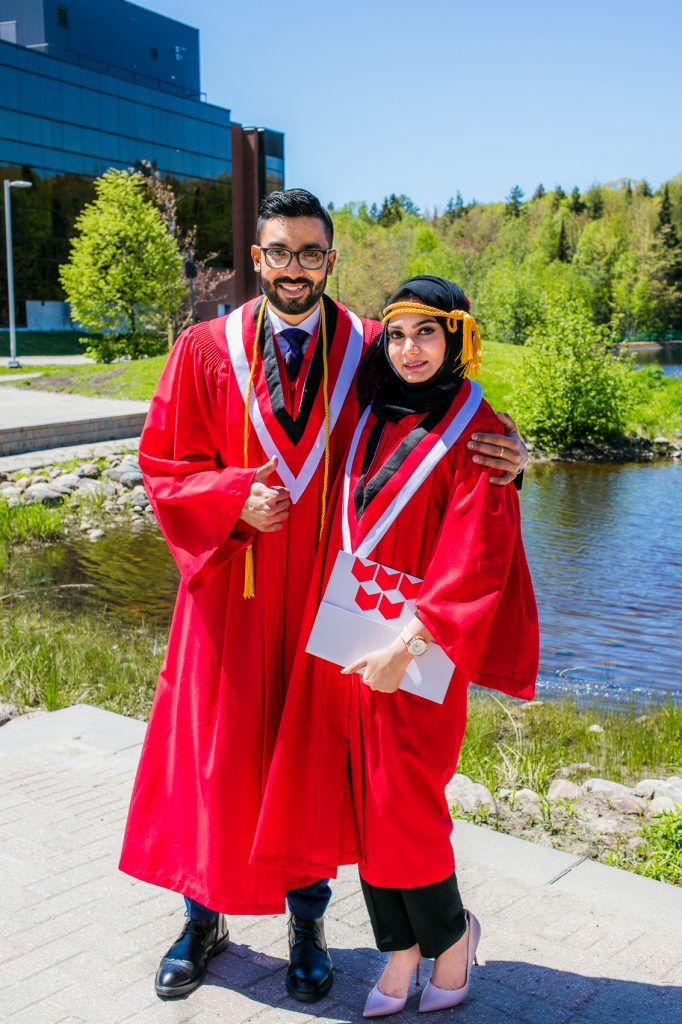
Ramiz and his wife, Faeqa Farooq, were both accepted for postgraduate diplomas at Canadore College in North Bay, Ontario where Ramiz earned a certificate in project management and IT with academic honours in 2019.
Until the Centre's founding, Saskatchewan lacked the research services to co-ordinate knowledge of child trauma across diverse sectors, programs and stakeholders. The CTRC focuses on multidisciplinary research and collaborates with the Ministries of Health, Justice, Education and Social Services, as well as other agencies across Canada. This is helping mitigate the causes of child trauma and its long-term impacts, which will help spur transformational change, not only in Saskatchewan, but around the globe.
"Child trauma is far more common than we think," says Reid. "Any child from any background or socioeconomic group can be living with trauma. Traumatic events such as poverty, addiction, domestic abuse, neglect and violence in the home can dramatically impact a young person's life. When these lives are derailed, the community at large bears the consequences - from public services that are burdened to employers unable to benefit from a young person's potential."
The CTRC became an official entity on March 10, 2020. One day later, the World Health Organization declared COVID-19 a global pandemic. "I met with the team and said 'If we can't be relevant now, and respond to how COVID-19 will impact children and their teachers, then we don't deserve our jobs.' So we got to work with coinciding research projects to support those in child-serving capacities, including attending to the dramatic mental health impacts of COVID-19, and ultimately, how this has impacted the mental state of teachers, administrators and school staff," says Reid.
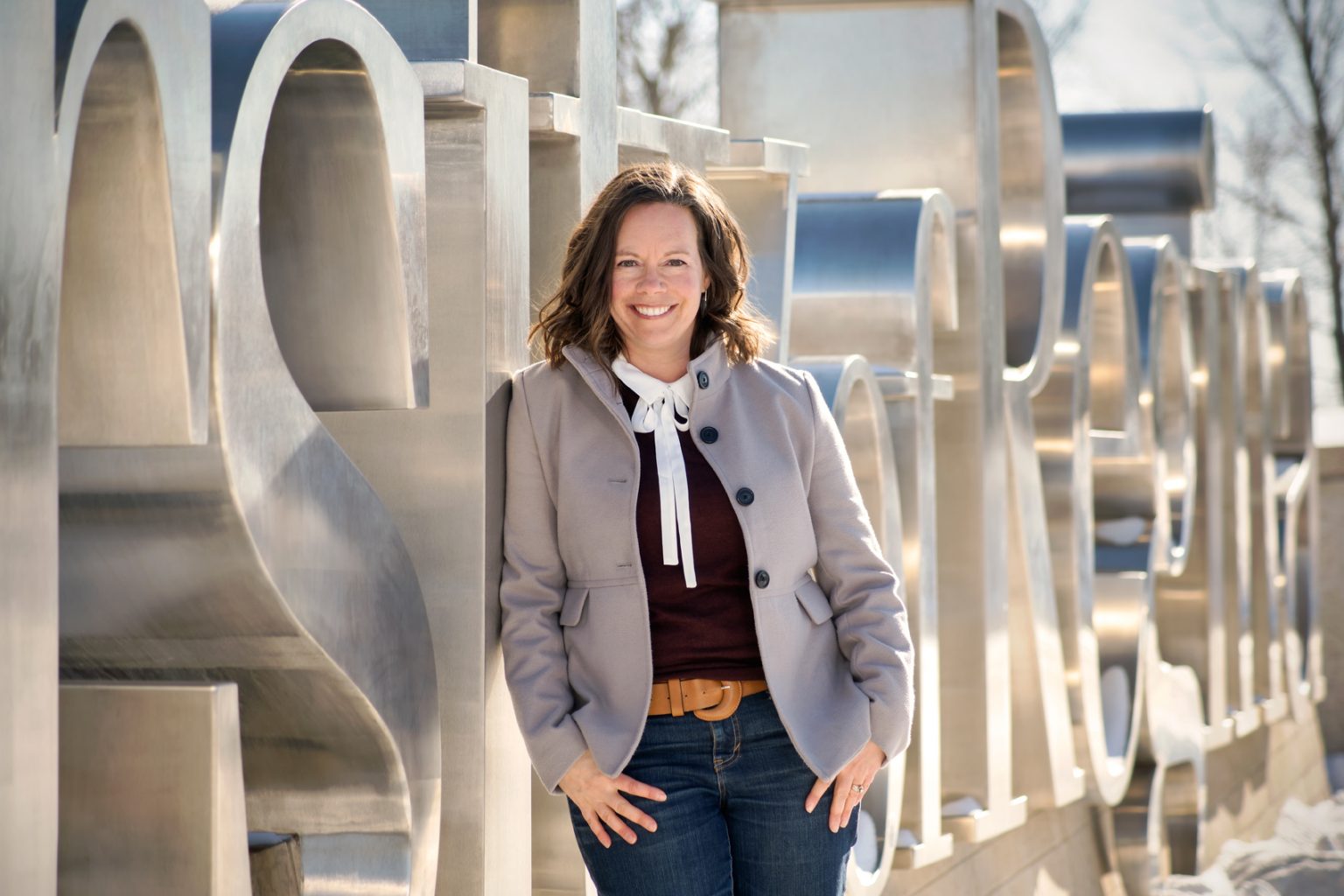
Dr. Nathalie Reid, director of the Child Trauma Research Centre.
Being able to respond on an international scale meant having someone on the team able to tackle the digital demands of the CTRC. Ramiz fit the bill. Before coming to Canada, he received his undergraduate degree in Electronics and Telecommunications Engineering in Dhaka, Bangladesh. Anxious to come to Canada, he and his wife were both accepted for postgraduate diplomas at Canadore College in Ontario, where Ramiz obtained a certificate in Project Management
and IT with academic honours. He was then accepted into the Kenneth Levene Graduate School of Business at the U of R where he's pursuing his master's of Administration in Leadership.
"Rashique has absolutely wowed us with his ability to get our website up and running (www.childtraumaresearch.ca), build our Digital Connections Hub, research and develop secure data storage, and help us throughout every stage of operation," says Reid. "His willingness to do whatever it takes to get the ball rolling has really impressed the entire team."
Ramiz blushes at the compliments, humbled at his good fortune. He admits he was scared at first, but says he was welcomed into the fold by colleagues who are "just like family." He adds that CTRC's culture of inclusion has helped him build his confidence.
His first project was to develop the Digital Connections Hub, an online resource for those in child-serving capacities to support vulnerable children and families in the midst of the pandemic and beyond. The website synthesizes a vast quantity of research and translates it into two-page briefs and information posters. Feedback on the Hub has come in from as far away as the Philippines. Ramiz developed a collection of infographics and poster material for the Hub that can be easily digested by different age groups. "We're on all of the social media channels like Facebook, Instagram, LinkedIn and Twitter," he says. "I'm also making child wellness posters that young kids can relate to about mental well-being."
Ramiz's second project was to develop a three-part survey in conjunction with the Faculty of Education. "The first part of the survey dealt with the reality of what Canadian teachers, administrators and school staff faced when the pandemic first hit," he explains. "We came up with multiple photos of a teacher sanitizing a desk and trying to maintain safe distance in the classroom. We then offered 21 anecdotal responses that a teacher could apply to those photos, from hostile, afraid and nervous to excited, inspired and enthusiastic. While teachers have had to focus on the educational needs of students, they've also been faced with huge stress in re-thinking the way they teach."
Ramiz says they wanted to make sure the responses were analyzed accurately. "We did our coding based on the responses and created groupings from somewhat positive to somewhat negative to get the exact emotional response," he says.
The second part of the survey was then sent to teachers, administrators and school staff when schools reopened after the lockdown. The third part of the survey, released in May, focused on the mental health and wellbeing of those same stakeholders in the midst of the vaccination rollout.
"What the survey is showing us is that teachers need more funding from governments to balance the educational and health needs of children during COVID-19," he says. "Based on our results, teachers are afraid for their own health and that of their students."
Future projects for Ramiz include: developing a website for a conference called Supporting Systemic Responses to Sexual Violence in conjunction with the Regina Sexual Assault Centre; designing a non-credit professional certificate in trauma-sensitivity and trauma-informed practices; and participating in the writing of grant proposals. Ramiz is also working with a team to help develop resilience in schools by creating a neurological-based tool kit for vulnerable kids.
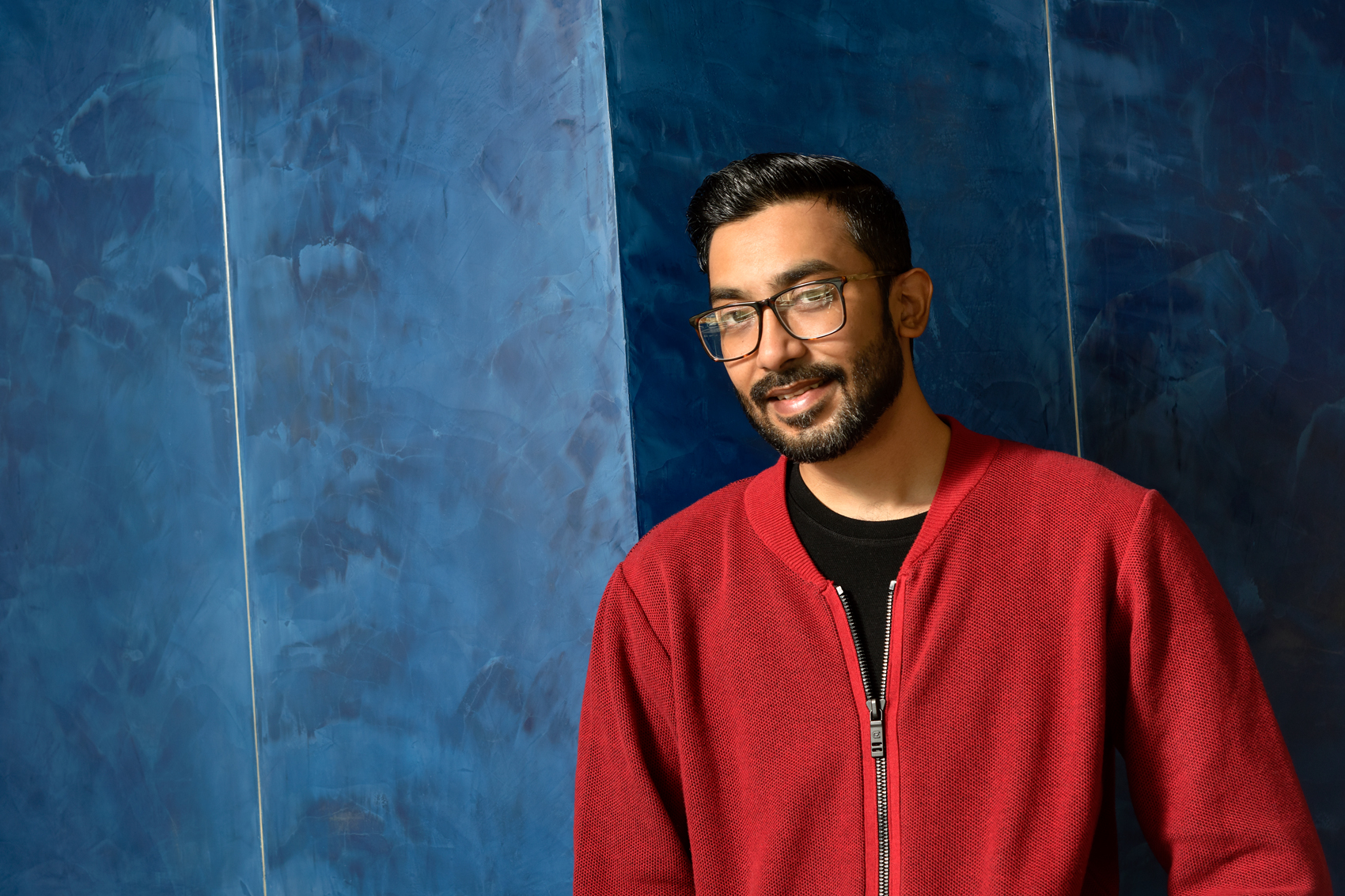
Ramiz says that Saskatchewan has been so welcoming to him and his family that he wants to stay, raise his kids in the province and give back to the community.
"Rashique was hired as a communications person, but we're discovering he has so much more to offer the CTRC," Reid says. "His skills and insight are invaluable."
Ramiz believes it was fate that landed him such meaningful work - a chance to gain insight into his own difficult past and use the lessons learned to help others facing trauma.
"Oh boy, how much time do we have?" the 29-year-old asks, unsure where to begin. "My father moved us around a lot, going from one failed business to another. He always had big dreams, investing all of his money, but those dreams never materialized. Whenever the business would go bad, the whole family was affected. I never really made friends because we were always moving," he confides. "I was a very skinny boy and I have scoliosis (curvature of the spine), so the public-school uniforms never fit. The pants were always very loose. One day, one of the boys pulled them right off me, in front of my classmates, and I remember crying as I ran back home."

Ramiz and his bride Faeqa Farooq pose on their wedding day with members of Ramiz's family. (Back row, left to right) Ramiz's mother Mahbuba Parveen,
sister Reyan, and his late father Mohammad Liaquat Hossain. The photo was taken in Dhaka, Bangladesh in December 2016.
Ramiz pauses for a moment, as if reliving that difficult memory. "I had to wear a thick belt to keep my muscles strong because of my back," he continues. To this day, he must take breaks every hour so excruciating pain doesn't set in. "Because of my condition, I lived through a lot of mental trauma of being devalued by relatives and friends. It haunted me for a long time, which affected my confidence."
Ramiz remembers travelling to another country when he was older, and his belt got him confused with a terrorist.
"I had a big beard and I was harassed by security because they thought I was a suicide bomber, pointing to my big belt and beard. I think that's the reason my father changed my last name, but it didn't really help in that situation." Ramiz and his family are Bangladeshi Muslim. He says his father, Mohammed Hossain, didn't want his children to experience the same kind of intolerance that he experienced, so he changed the kids' last names from Hossain to Ramiz so they might escape overt racism.
"Because my family moved so much, I did not have good grades and I struggled with English. The first time I applied to the U of R, my application was rejected," he admits.
Ramiz's positive outlook and unflappable resolve have earned him the reputation of someone who is helping shape the kind of world in which we all want to live. His tenacity to set the bar extremely high in his co-op position, while single-handedly managing an overseas business late into the night so he can provide for his mother and sister in Bangladesh, is one of the reasons why Ramiz has endeared himself to so many.
Ramiz continues to give his all in every aspect of his life. The late cultural anthropologist Margaret Mead said: "Never doubt that a small group of thoughtful, committed people can change the world. Indeed, it is the only thing that ever has." Although she died nearly two decades before Ramiz was born, one could argue that Mead was envisioning a world made better by people like Ramiz. "I keep reminding myself that I am extremely lucky to be here and getting the education that I am," he says thoughtfully. "Now that I am a father, I have even more reason to make the world a better place."
[post_title] => The resilient young Mr. Ramiz
[post_excerpt] =>
[post_status] => publish
[comment_status] => open
[ping_status] => open
[post_password] =>
[post_name] => the-resilient-young-mr-ramiz
[to_ping] =>
[pinged] =>
[post_modified] => 2021-06-02 18:43:35
[post_modified_gmt] => 2021-06-03 00:43:35
[post_content_filtered] =>
[post_parent] => 0
[guid] => https://www.degreesmagazine.ca/?p=5048
[menu_order] => 0
[post_type] => post
[post_mime_type] =>
[comment_count] => 0
[filter] => raw
)
WP_Post Object
(
[ID] => 4945
[post_author] => 12
[post_date] => 2021-05-27 12:38:03
[post_date_gmt] => 2021-05-27 18:38:03
[post_content] =>
The University of Regina and local firm MacPherson Engineering have enjoyed a 25-year relationship that has seen the two parties collaborate in numerous ways. Together, the partners have developed unique engineering curriculums and embarked on award-winning community projects. The firm has a long history of providing Co-op placements and innovative engineering solutions, mentoring students and hiring U of R graduates.
The strong working relationship between the University and MacPherson Engineering dates back to the company's incorporation in 1996. In fact, the company's first project with the University took place that same year. Since then, notes company president Murdoch MacPherson, numerous U of R students have completed Co-op placements with the company, along with summer students from various technical and degree programs. "Presently, 35 per cent of our team started out with MacPherson Engineering as students," he notes.
Two engineers with MacPherson - Jared Larson and Brad Lulik BASc'16, MASc'20 - have been heavily involved, serving as teaching assistants in engineering labs and as mentors to teams of fourth-year students completing their projects. Larson, a MacPherson Engineering partner specializing in HVAC engineering (heating, ventilation and air conditioning), and Lulik first met at a Regina Engineering Students' Society mixer, when Lulik was in the second year of his industrial systems engineering undergraduate program.
In recognition of the company's $15,000 donation toward the College Avenue Campus Renewal project, the University named the mechanical room and several fan rooms in the College Building in the company's honour. "We appreciated that," MacPherson says, "but it is the donation of our time and knowledge - particularly to the engineering program - that we are especially proud of."
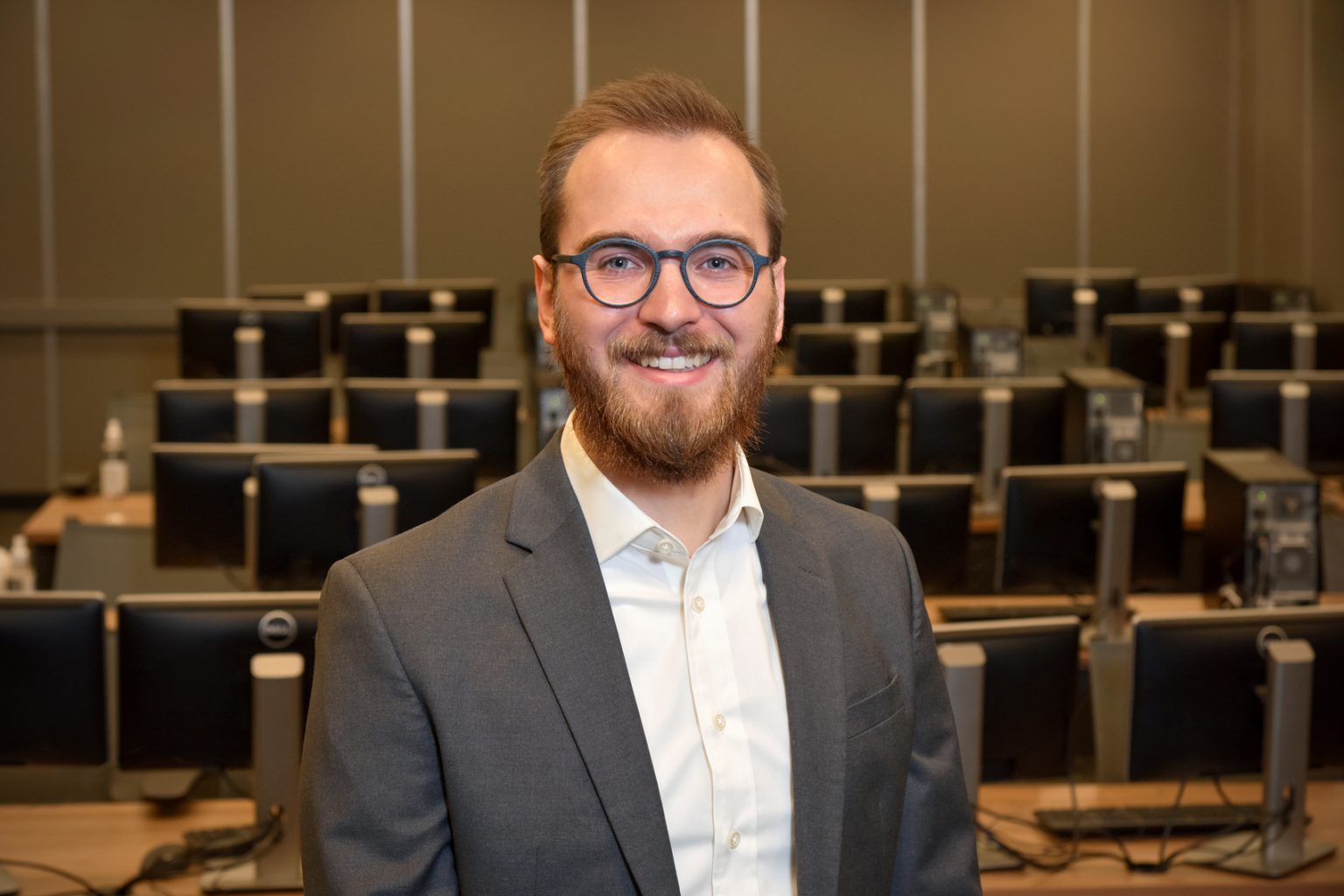
University of Regina Engineering graduate Brad Lulik.
In other professions such as medicine, explains Dr. Esam Hussein, dean of the Faculty of Engineering and Applied Science, students interact with professionals in the field. "We try to do this in engineering, especially through the capstone projects: design projects intended to give students a taste of what real engineering is."
Larson would later mentor Lulik and other members of a fourth-year student team on their capstone project (a culminating assignment at the end of the academic program) in 2016. The team worked on an energy assessment of the building that houses the Little Souls Daycare in Regina, a non-profit organization with limited financial resources. The project went on to win a global design competition sponsored by ASHRAE, the American Society of Heating, Refrigeration and Air-Conditioning Engineers, a volunteer-run international organization that promotes standards and best practices for the engineering profession.
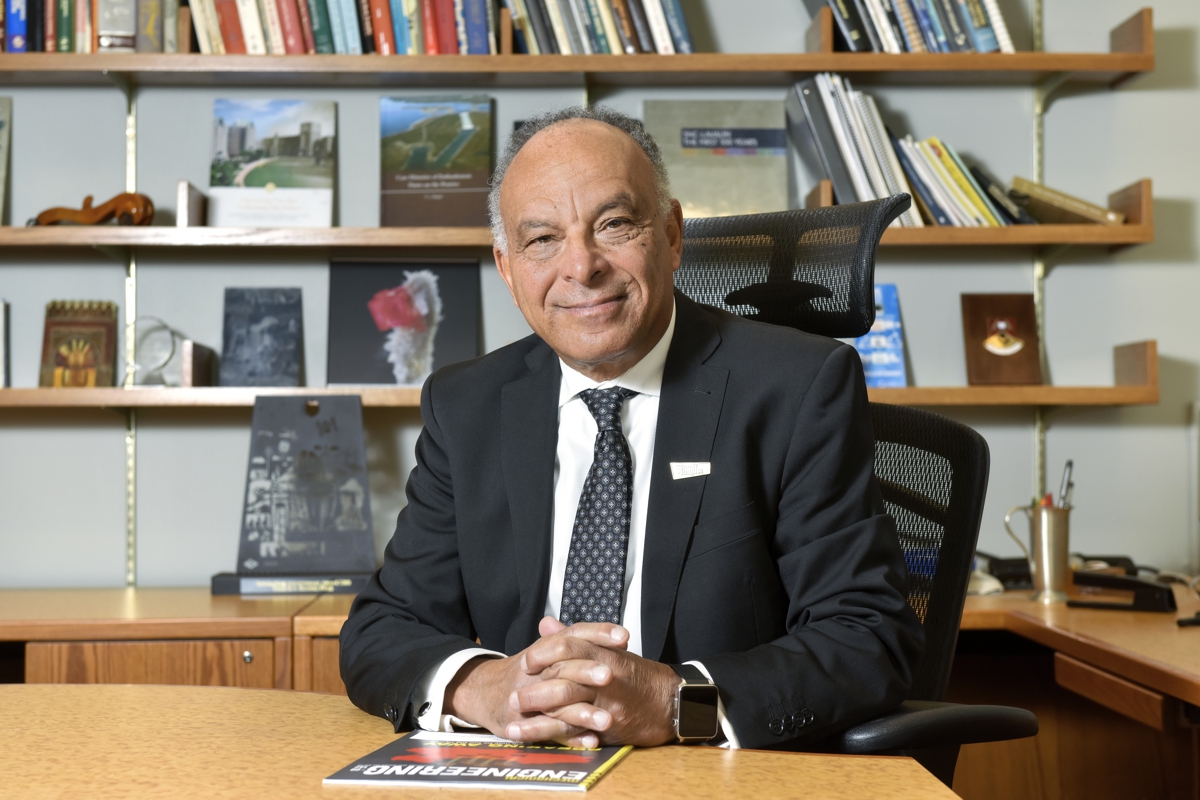
Dr. Esam Hussein, dean of the Faculty of Engineering and Applied Science.
Fourth-year students present their capstone projects to their family, friends and peers on Project Day, one of the highlights of the school year. Because of public health restrictions, Project Day 2020 and 2021 were presented virtually over several days.
At the time Larson was mentoring the student team, he was also serving as student activities chair for the Regina chapter of ASHRAE. The organization was looking for ways to make closer connections with the University of Regina and encouraging the development of a full HVAC course at the University.
Lulik and Larson both agree that working with students is rewarding and a good investment of their time. Lulik recalls how, as a student, he was grateful when members of industry shared their time with him.
As a first step, in 2013, Larson was invited to speak to an engineering class, with a similar invitation extended the following year. The interest shown by students led to a decision to develop a full course. At that point Larson recruited Lulik to provide industry input to help faculty members develop the course. Larson describes the course as a joint venture, with faculty handling the lectures while Lulik and other practising professionals serve as teaching assistants and help students with lab work.
"We designed the course to leave the door open for industry participation, including U of R alumni and representatives from ASHRAE," says Larson. "We think the HVAC course gives our students a leg up on grads from other universities."
Lulik and Larson both agree that working with students is rewarding and a good investment of their time. Lulik recalls how, as a student, he was grateful when members of industry shared their time with him. "I understood they were busy," he says, "but somehow they found time to offer advice and point me in the right direction."
Lulik is also a vocal champion for the student teams he mentors. Two teams received grants from ASHRAE and APEGS (Association of Professional Engineers & Geoscientists of Saskatchewan) to help them build their own lab apparatus as part of their projects. One of those teams won a Global Excellence Award at an ASHRAE conference in 2020. Currently, he adds, another team has received a grant from ASHRAE to help them design and build a refrigeration system that was part of their capstone project this year.
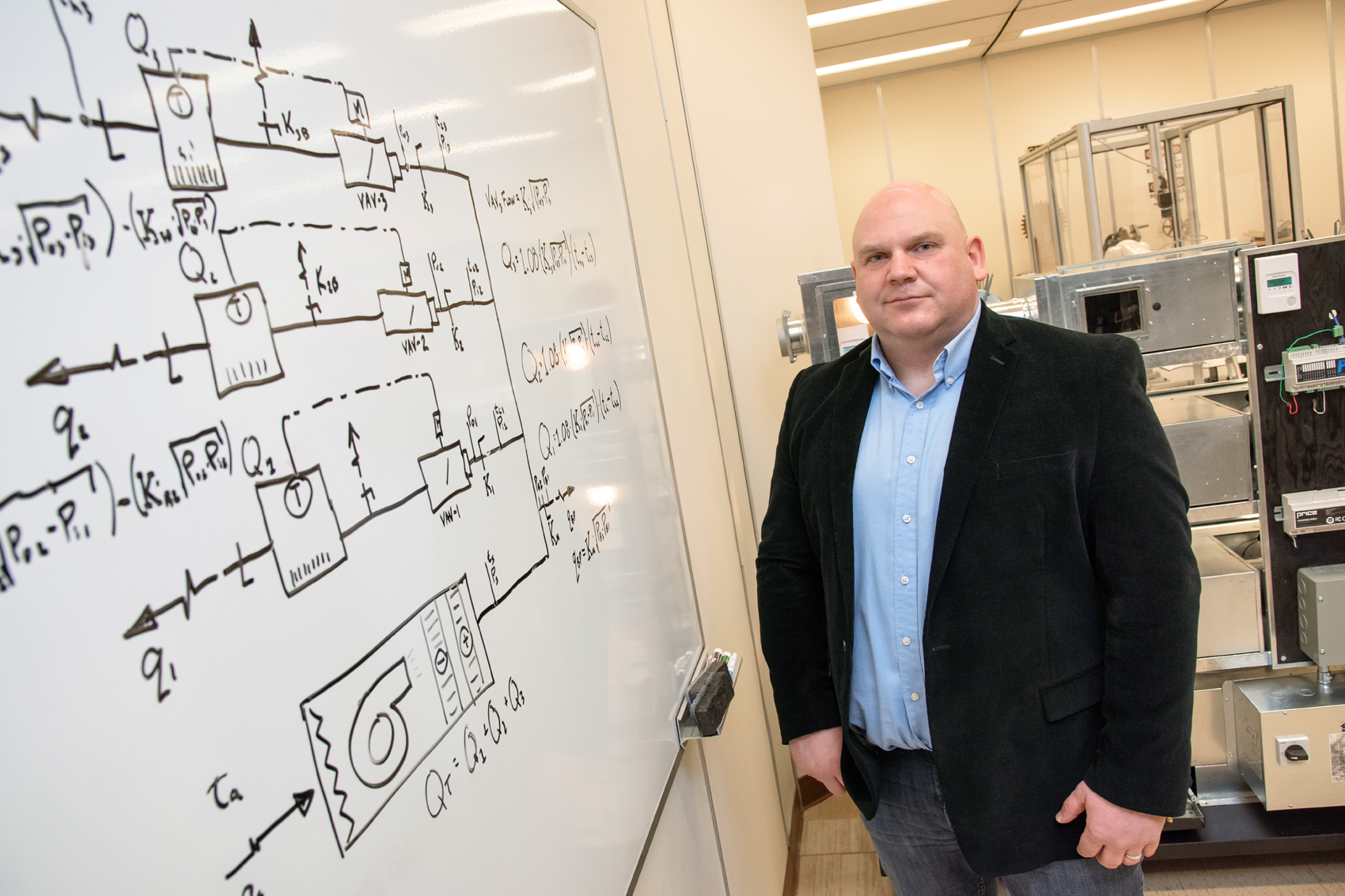
MacPherson Engineering's Jared Larson is a teaching assistant in engineering labs and mentors fourth-year U of R engineering students.
Lulik's and Larson's experience and expertise were crucial to the Blanket of Warmth for Our Nations Homes project, an initiative designed to improve housing conditions on the Star Blanket Cree Nation. The project's beginnings came when Aura Lee MacPherson (Murdoch's wife), then the office manager for MacPherson Engineering, worked with Wendell Starblanket of the First Nation to organize a ceremony at the Treaty 4 Governance Centre in Fort Qu'Appelle.
A chance remark by Starblanket about mould, high humidity and poor air quality in the basement of his home on the First Nation caught her attention. At his invitation, the MacPhersons visited Starblanket's home and assessed the conditions in the basement. They recognized that the patented hybrid passive heating technology developed by a Canadian company called RadiantLink had the potential to improve those conditions.
RadiantLink is a heat transfer system that uses a coil attached to the furnace to heat a food-grade glycol mixture that is pumped through plastic tubing attached to wall panels and then covered with drywall. The system turns the walls into passive heat sources.
The MacPhersons realized that the variety of tasks involved in the project would require recruiting other participants. Aura Lee, a strong believer in the United Nations' 17 goals for sustainable development, including the need to develop partnerships to achieve those goals, set to work finding partners. She began cold-calling potential sponsors and suppliers for the project. "In my heart I was thinking 'Do not make me tell Wendell this cannot happen,'" she recalls."To my sheer amazement not one person said 'No' to the project."
The 2018 partnership with the Star Blanket Cree Nation, MacPherson Engineering and Uponor - the panels and tubing supplier - installed the system in Starblanket's home in just one day. While the Starblankets could feel the improvements in the basement, the next step was to measure what differences passive heating had made to health, safety and comfort. Since Aura Lee MacPherson sees the University of Regina as "craving problems to solve", she approached the Faculty of Engineering and Applied Science for help.
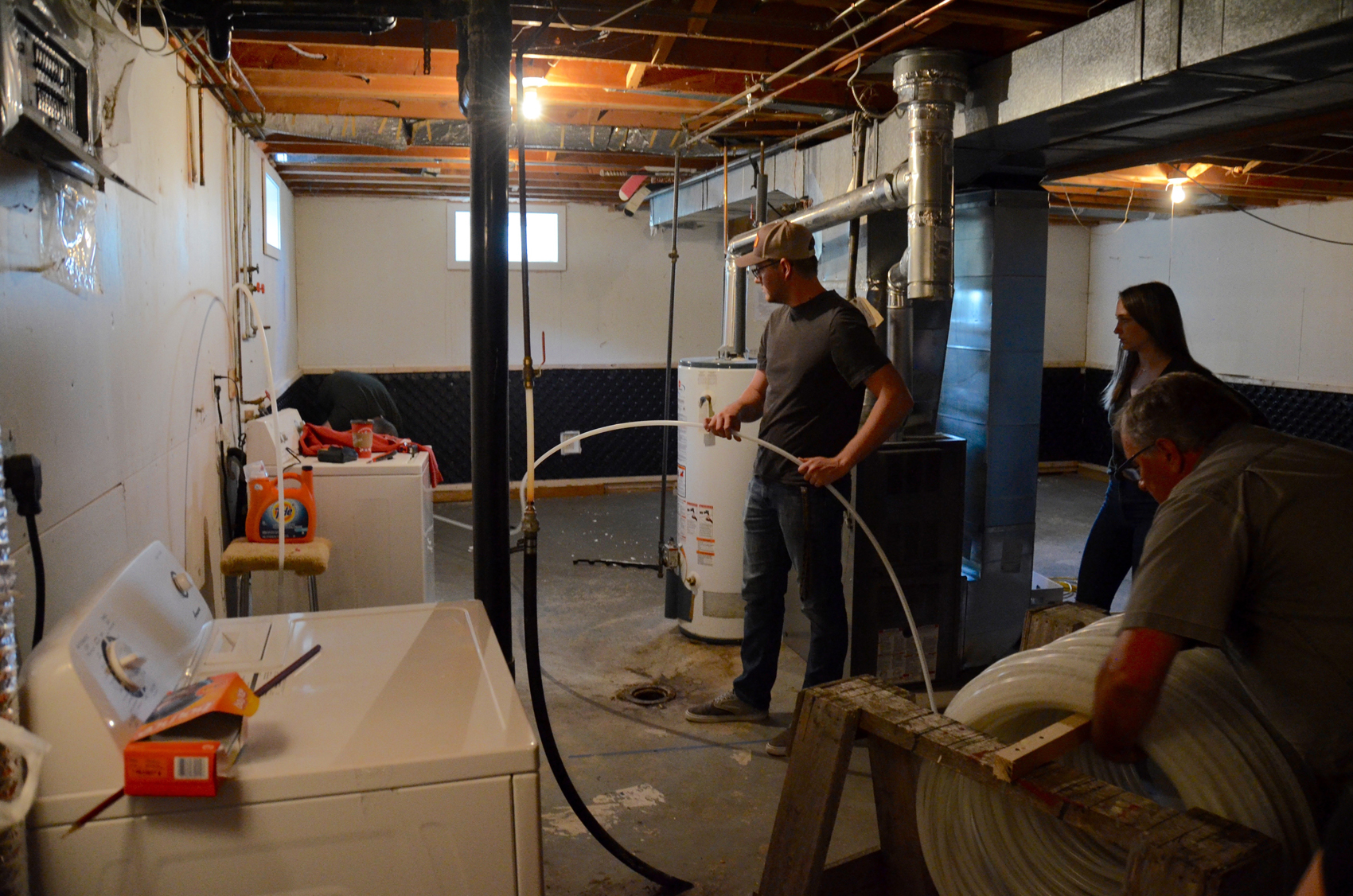
U of R Engineering students install RadiantLink, a heat transfer system, into a home on the Star Blanket Cree Nation. (Photo courtesy of Aura Lee MacPherson.)
Professor Amr Henni, who was teaching a U of R capstone project course at the time, proposed a project to his students that would involve measuring the conditions in Starblanket's basement over the winter and comparing them to those in a similar home nearby without the passive radiant heating system.
A team composed of Kennedy Dollard BASc'19, Anton Movchan BASc'19 and Jeremy Shiplack BASc'19 took on the project.
At the beginning of the heating season in October, the team, with Lulik's guidance, installed data loggers and sensors in two basements to: a) monitor temperatures and humidity and b) measure natural gas and electricity consumption. Cables were installed from a data collection point inside to a fixture outside the homes so that the students could download the data every few weeks without having to enter the homes. In February 2019, the team began preparing their Capstone presentation. They found that the basement with the radiant heating system was 3.5˚ C warmer than the basement without the system, and surface humidity reached a high of 41 per cent in Starblanket's basement, compared with levels as high as 55 per cent in the other home. The lower humidity meant mould would be less likely to form in the space with radiant heating. They also found that the radiant heating system did not increase natural gas consumption, but instead reduced electricity consumption by almost $900 a year, since space heaters were no longer needed in the basement.
"The best part of the entire project," Dollard says, "was seeing something you designed go in and make a difference. When I was choosing a field of study, I wanted to choose something that would help people - that would have an impact.
As the second part of their project, the team also performed energy modelling in a similar home and prepared schematics and sizing requirements for a second installation. By making some simple changes, such as replacing copper fittings with PVC piping, they trimmed 30 per cent from the cost of materials for the second installation. "Brad (Lulik) made sure we had all the elements documented; that we had a well-rounded project," Dollard observes. "We could not have done it without his guidance."
Larson says when the team made their Project Day presentation, he could see and feel the pride they had in the work they had done, knowing that the project made a positive difference. The student team then presented a written proposal for a second project at Star Blanket. With a $5,000 grant from APEGS and monetary and in-kind support from MacPherson Engineering, Uponor, Fries Tallman Lumber and Anaquod Plumbing and Heating, the second installation was completed in June 2019.
The members of the student team assisted with the installation, a postscript to the completion of their graduating year. While the work was underway, a community lunch was held on the First Nation, where people could learn more about the installation, assist with the work or visit with others. In a video produced afterwards, Chief Michael Starr said the project was about connecting, partnering and making each other feel welcome.
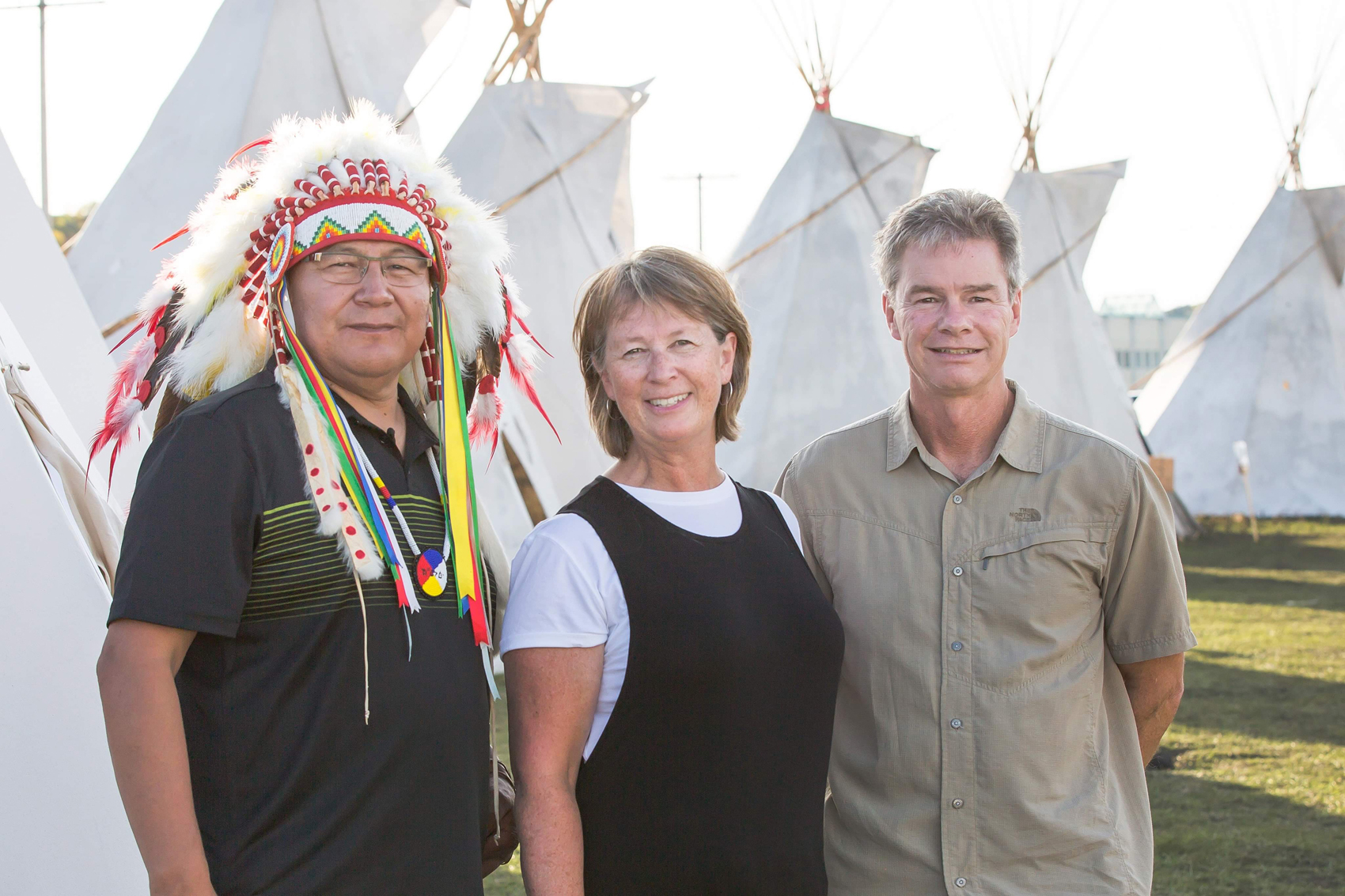
Chief Michael Starr of the Star Blanket Cree Nation, Aura Lee and Murdo (Murdoch) MacPherson. (Photo courtesy of Aura Lee MacPherson.)
"The best part of the entire project," Dollard says, "was seeing something you designed go in and make a difference. When I was choosing a field of study, I wanted to choose something that would help people - that would have an impact. I think there has been a shift in the last 10 years within the profession, with more emphasis on how engineering can serve people."
The Blanket of Warmth project created another development opportunity, where representatives from the University and MacPherson Engineering travelled to Chief Payepot School north of Regina to host an engineering workshop, discuss the applied sciences and share the story of the work done at Star Blanket with the students there. While the workshop was an optional activity for her, Dollard says it was important for her to be there. It is important to have role models who are a reflection of yourself, she says, and having visible female role models in a field dominated by men was pivotal in her decision to pursue engineering.
Dean Hussein says the Star Blanket project is the one that is closest to his heart, because it shows young people what engineering is about, while solving a real problem affecting people's everyday lives. "We may not always notice it in operation, but our quality of life depends on it, for example, in the water, heat and power we rely on," he says.
Soon after the project was completed, the United Nations Regional Centre of Expertise on Education for Sustainable Development in Saskatchewan recognized the project at its award ceremony for sustainability initiatives. The project is also earning accolades from the industry. The team was honoured to receive the APEGS 2021 Exceptional Engineering/Geoscience Project Award at the organization's annual recognition event on April 30 and Sustainable Architecture & Buildings magazine selected the project for a 2021 Canadian Green Building Award.
"The best part of the entire project," Dollard says, "was seeing something you designed go in and make a difference. When I was choosing a field of study, I wanted to choose something that would help people - that would have an impact. I think there has been a shift in the last 10 years within the profession, with more emphasis on how engineering can serve people."
MacPherson Engineering is currently working with Henni and four capstone students on a continuation of the project, wrapping the plastic tubing around the windows in a renovated home and collecting the data over the winter months. "The results look promising," says Aura Lee MacPherson, "and we expect to soon know if this should be added to the Blanket of Warmth for Our Nations Homes. We continue to improve the system and look for grants to improve homes with poor air quality on Star Blanket Cree Nation."




[post_title] => Working together for the greater good
[post_excerpt] =>
[post_status] => publish
[comment_status] => open
[ping_status] => open
[post_password] =>
[post_name] => working-together-for-the-greater-good
[to_ping] =>
[pinged] =>
[post_modified] => 2021-12-01 14:41:43
[post_modified_gmt] => 2021-12-01 20:41:43
[post_content_filtered] =>
[post_parent] => 0
[guid] => https://www.degreesmagazine.ca/?p=4945
[menu_order] => 0
[post_type] => post
[post_mime_type] =>
[comment_count] => 0
[filter] => raw
)
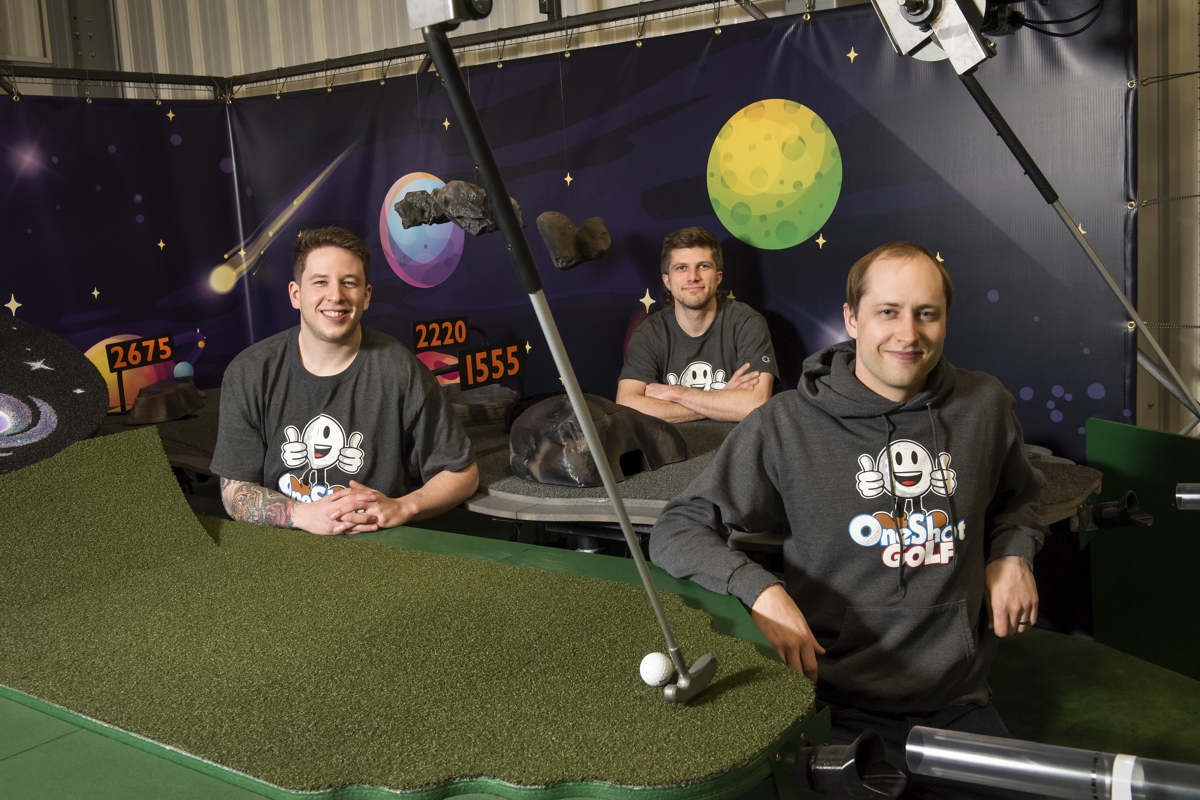
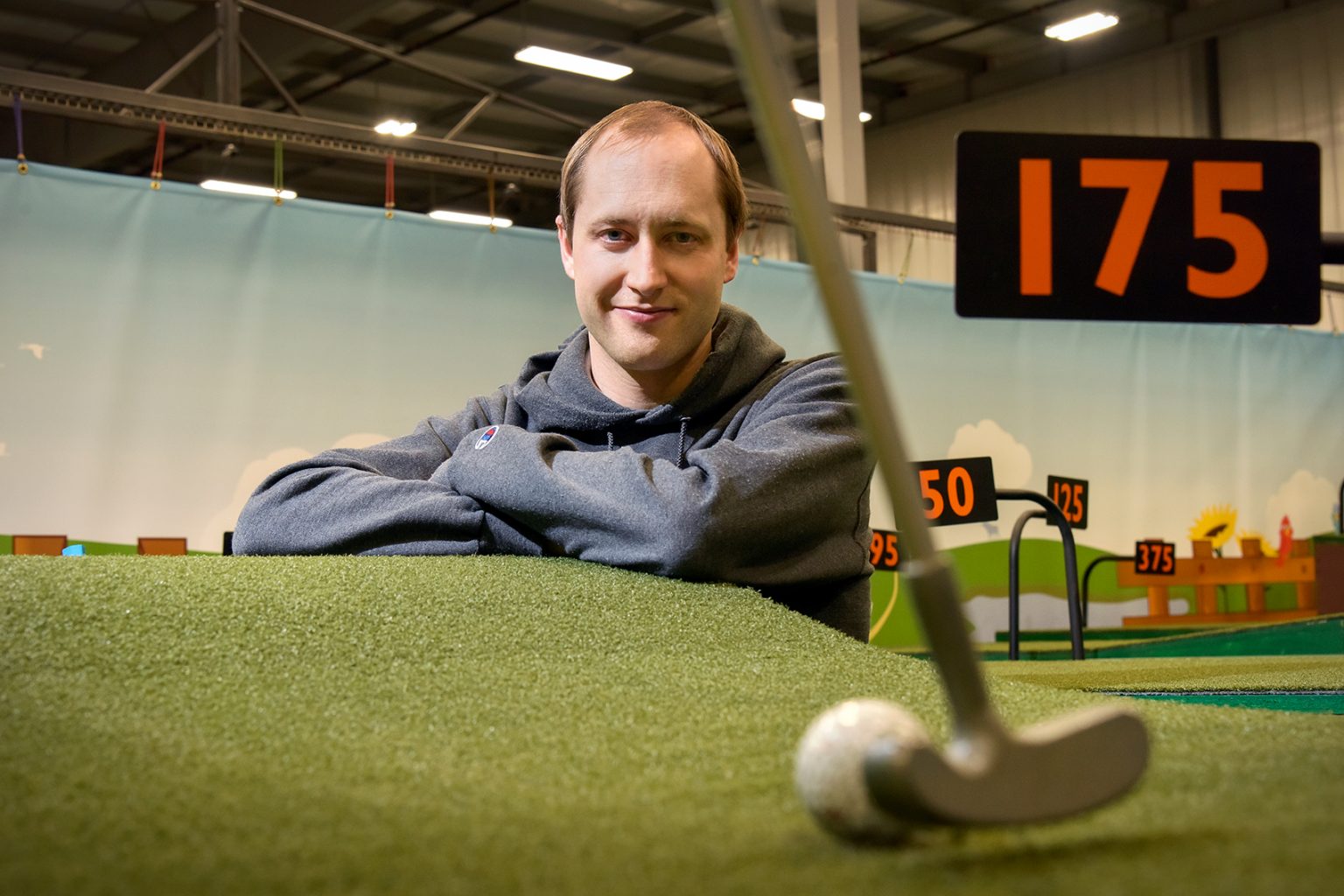
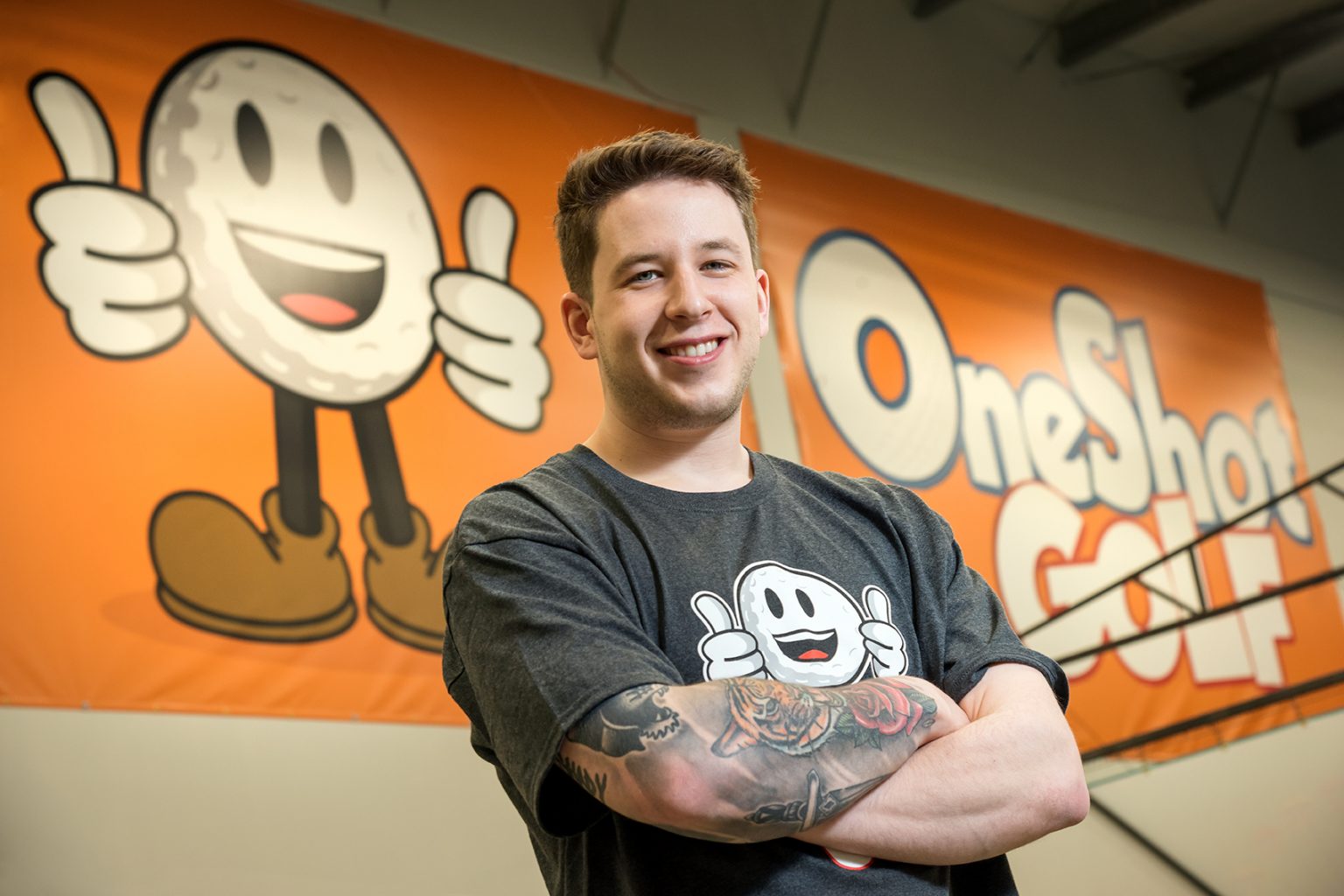
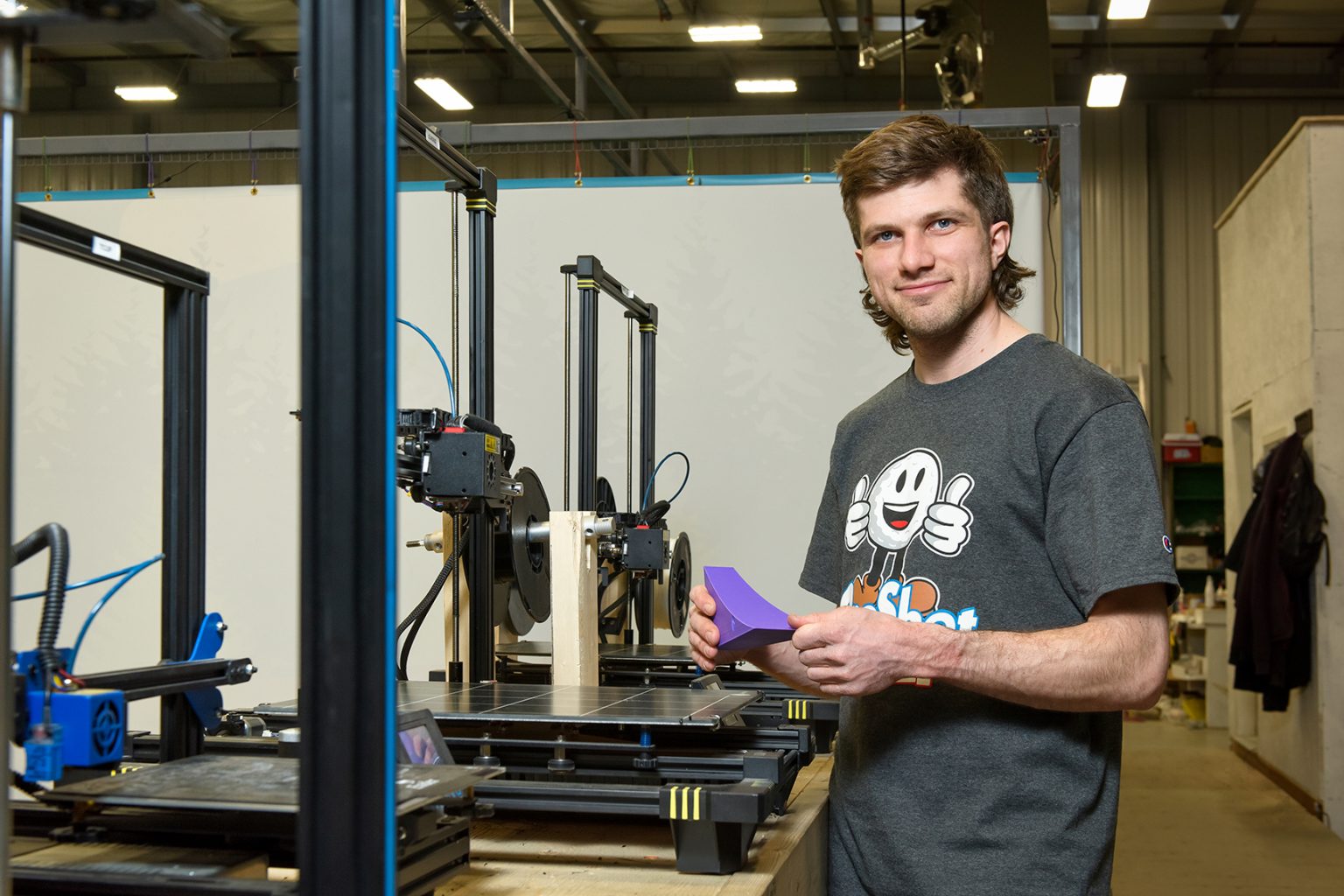
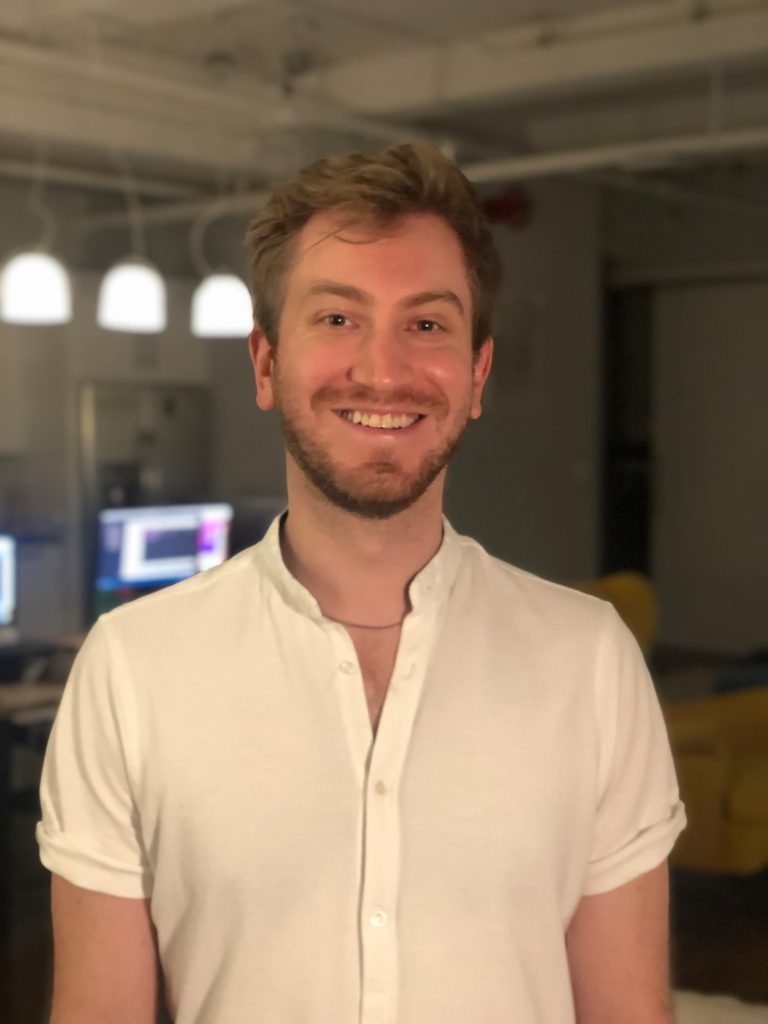
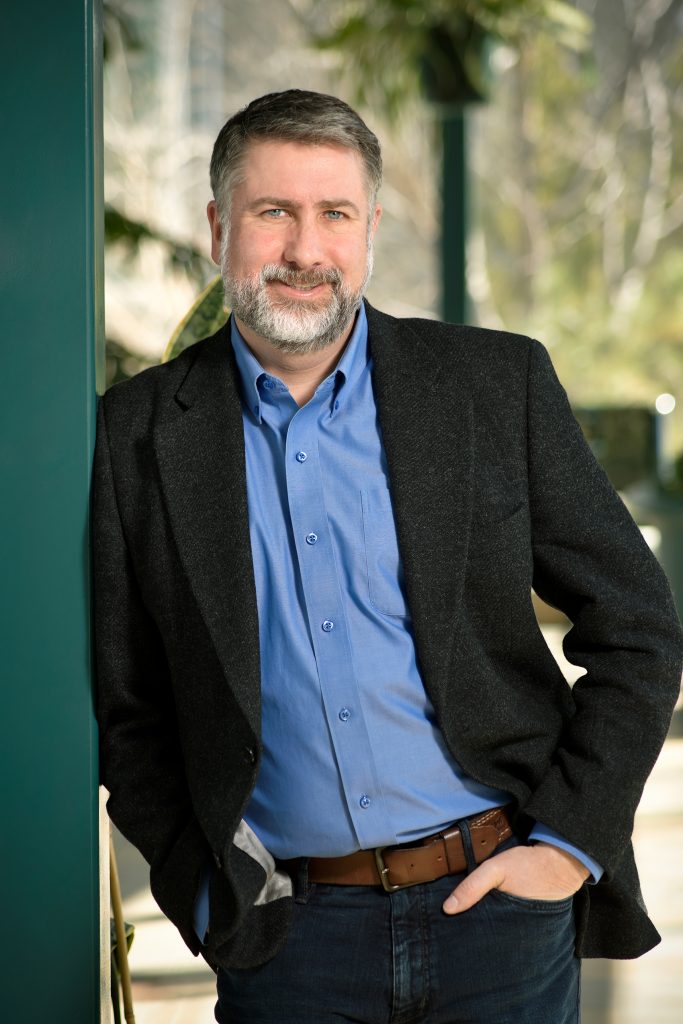

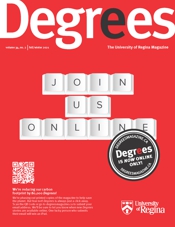

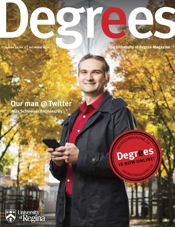


 Ramiz and his wife, Faeqa Farooq, were both accepted for postgraduate diplomas at Canadore College in North Bay, Ontario where Ramiz earned a certificate in project management and IT with academic honours in 2019.
Ramiz and his wife, Faeqa Farooq, were both accepted for postgraduate diplomas at Canadore College in North Bay, Ontario where Ramiz earned a certificate in project management and IT with academic honours in 2019.
 Dr. Nathalie Reid, director of the Child Trauma Research Centre.
Being able to respond on an international scale meant having someone on the team able to tackle the digital demands of the CTRC. Ramiz fit the bill. Before coming to Canada, he received his undergraduate degree in Electronics and Telecommunications Engineering in Dhaka, Bangladesh. Anxious to come to Canada, he and his wife were both accepted for postgraduate diplomas at Canadore College in Ontario, where Ramiz obtained a certificate in Project Management
Dr. Nathalie Reid, director of the Child Trauma Research Centre.
Being able to respond on an international scale meant having someone on the team able to tackle the digital demands of the CTRC. Ramiz fit the bill. Before coming to Canada, he received his undergraduate degree in Electronics and Telecommunications Engineering in Dhaka, Bangladesh. Anxious to come to Canada, he and his wife were both accepted for postgraduate diplomas at Canadore College in Ontario, where Ramiz obtained a certificate in Project Management Ramiz says that Saskatchewan has been so welcoming to him and his family that he wants to stay, raise his kids in the province and give back to the community.
Ramiz says that Saskatchewan has been so welcoming to him and his family that he wants to stay, raise his kids in the province and give back to the community.
 Ramiz and his bride Faeqa Farooq pose on their wedding day with members of Ramiz's family. (Back row, left to right) Ramiz's mother Mahbuba Parveen,
sister Reyan, and his late father Mohammad Liaquat Hossain. The photo was taken in Dhaka, Bangladesh in December 2016.
Ramiz and his bride Faeqa Farooq pose on their wedding day with members of Ramiz's family. (Back row, left to right) Ramiz's mother Mahbuba Parveen,
sister Reyan, and his late father Mohammad Liaquat Hossain. The photo was taken in Dhaka, Bangladesh in December 2016.
 University of Regina Engineering graduate Brad Lulik.
University of Regina Engineering graduate Brad Lulik.
 Dr. Esam Hussein, dean of the Faculty of Engineering and Applied Science.
Dr. Esam Hussein, dean of the Faculty of Engineering and Applied Science.
 MacPherson Engineering's Jared Larson is a teaching assistant in engineering labs and mentors fourth-year U of R engineering students.
MacPherson Engineering's Jared Larson is a teaching assistant in engineering labs and mentors fourth-year U of R engineering students.
 U of R Engineering students install RadiantLink, a heat transfer system, into a home on the Star Blanket Cree Nation. (Photo courtesy of Aura Lee MacPherson.)
U of R Engineering students install RadiantLink, a heat transfer system, into a home on the Star Blanket Cree Nation. (Photo courtesy of Aura Lee MacPherson.)
 Chief Michael Starr of the Star Blanket Cree Nation, Aura Lee and Murdo (Murdoch) MacPherson. (Photo courtesy of Aura Lee MacPherson.)
Chief Michael Starr of the Star Blanket Cree Nation, Aura Lee and Murdo (Murdoch) MacPherson. (Photo courtesy of Aura Lee MacPherson.)